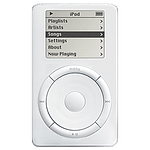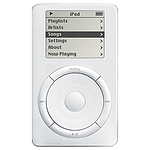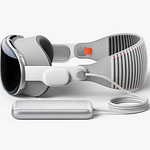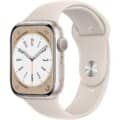- All Apple Devices
- iPod
- Apple iPod Classic 3rd Gen
Apple iPod Classic 3rd Gen
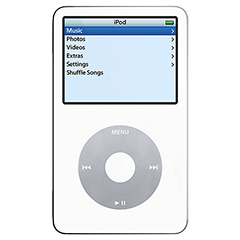


iPod Classic 3rd Gen
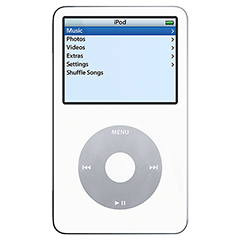
Product Brand: Apple
3.5
Pros
- Large storage capacity (up to 40 GB)
- Clear and bright colour display
- Long battery life
- Sleek and durable design
- Easy to navigate menus
Cons
- No video playback capability
- Limited support for newer software and technologies
- No Wi-Fi or Bluetooth connectivity
- No built-in FM radio
- Heavy and bulky compared to newer devices
Apple iPod Classic 3rd Gen Review and Features
Apple iPod Classic 3rd Gen also known as iPod with a dock connector was announced on April 29, 2003, by Apple as a completely redesigned third-generation iPod. Thinner than the previous models, the third-generation models replaced the FireWire port with a new proprietary 30-pin Dock Connector and introduced the Touch Wheel, a completely non-mechanical interface with the four auxiliary buttons located in a row between the screen and the touch wheel.
The four buttons are now backlit and are located in a row above the touch wheel (the previous models had buttons placed around the wheel). Software improvements include games, an alarm clock, the possibility to record voice and updated customization options.
The front plate had rounded edges, and the rear casing was slightly rounded. A new wired remote connector was introduced. Whereas first and second-generation iPods had an auxiliary ring around the headphone port for the remote, the third-generation iPods had a 4-pin jack adjacent to the headphone port.
The 10 GB model was sold for US$299, the 15 GB model for US$399, and the 30 GB model for US$499. All iPods were now compatible with Mac and Windows out of the box, requiring Windows users to reformat the iPod before use on a PC.
Both iTunes and Musicmatch Jukebox were bundled with all iPods. On the other hand, battery life has been estimated at eight hours, two hours less than the iPod classic 1st and the iPod classic 2nd generations. This was partially due to a smaller lithium-ion battery than a lithium polymer battery.
A 20 GB model replaced the 15 GB model, and the 30 GB model was upgraded to 40 GB on September 8, 2003. The Windows-based Musicmatch Jukebox software was made obsolete and replaced by iTunes 4.1, the first version of Microsoft Windows.
The iPod Classic (stylized and marketed as iPod classic and formerly iPod Video or just iPod) is a discontinued portable media player created and formerly marketed by Apple Inc.
Six generations of the iPod Classic and a spin-off (the iPod Photo) were later re-integrated into the main iPod line. All generations used a 1.8-inch (46 mm) hard drive for storage. The “classic” suffix was formally introduced with the rollout of the sixth-generation iPod on September 5, 2007.
Before this, all iPod Classic models were simply referred to as iPods; the first iPod released in 2001 was part of this line called “Classic”. It was available in silver or black from 2007 onwards, replacing the “signature iPod white”.
On September 9, 2014, Apple discontinued the iPod Classic. The sixth-generation 160 GB iPod Classic was the last Apple product to use the original 30-pin dock connector and the distinctive click wheel.
The iPod’s operating system is stored on its dedicated storage medium. An additional NOR flash ROM chip (either 1 MB or 512 KB) contains a bootloader program that tells the device to load its OS from the storage medium.
Each iPod has 32 MB of RAM, although the 60 GB and 80 GB fifth-generation and sixth-generation models have 64 MB. A portion of the RAM is used to hold the iPod OS loaded from firmware, but most of it serves to cache songs from the storage medium.
For example, an iPod could spin its hard disk up once and copy approximately 30 MB of upcoming songs into RAM, thus saving power by not requiring the drive to spin up for each song.
Custom firmware has also been developed, such as Rockbox (up to 1G – 6G requires emCORE) and iPodLinux (up to 5G, 6G has an encrypted firmware.), which offer open-source alternatives to the standard firmware and operating system.
Full Technical Specifications
General Technical Specifications
| Device Type | Portable Media Player |
| Initial Price |
US $299 for the 10 GB model. US $399 for the 15 GB model. US $499 for a 30 GB. |
| Models |
M8976LL/A 10 GB M8946LL/A & M9460LL/A 15 GB M9244LL/A 20 GB M8948LL/A 30 GB M9245LL/A 40 GB |
| Released | 28 April, 2003 |
| Status | Discontinued |
| Successor | iPod Touch |
| External Buttons and Connectors | Dock connector, remote connector, stereo minijack |
| Generation | 3rd |
| Colors | White |
| System Requirements |
Mac Requirements and Software Apple computer with built-in FireWire port; Mac OS X v10.1.5 or later (Mac OS X 10.2 or later recommended); CD includes iTunes for Mac OS X Windows Requirements and Software PC with built-in FireWire or USB 2.0, or Windows-certified FireWire or USB 2.0 card; Windows Me, Windows 2000 or Windows XP Home or Professional; CD includes MUSICMATCH Jukebox Plus 7.5 software |
| Customizable Settings |
Shuffle songs or albums Repeat one or all Soundcheck on or off Equalizer on or off Backlight timer Display contrast Alarms on, off, or silent Sleep timer Date and Time Contacts sort and display by first or last names Clicker on or off Languages: English, French, German, Japanese, Spanish, Italian, Dutch, Danish, Norwegian, Portuguese, Finnish, Swedish, Korean, Simplified Chinese, Traditional Chinese |
| Power Adapter |
6-pin FireWire connector AC input: 100V to 240V at 0.4 amp maximum Frequency: 50Hz to 60Hz DC output: 12V at 1 amp maximum |
| Input and Output |
Dock connector 3.5-mm stereo headphone jack Wired remote connector |
| iPod's Processor Type | ARM 7TDMI-derived CPUs (PP5002) |
| iPod's Processor Speed | 90 MHz (x2) |
| RAM | 32 Megabytes |
| iPod's Internal Memory |
10GB, 15GB, 20GB, 30GB, or 40GB hard disk drive Holds over 2500, 3700, 5000, 7500, or 10000 songs in 128-Kbps AAC format Stores data in FireWire or USB 2.0 disk mode 1.8” hard drive |
| Connectivity | FireWire port |
| FM Radio Support | Mac 10.1 |
| Operating System OS => Every computer system run on a base software called Operating System (OS). Operating System controls all basic operations of the computer (such as smartphone, PDAs, tablet computers and other handheld devices). The Operating System allows the user to install and run third party applications (apps), apps are used to add new functionality to the device. | Operating system for mobile devices based on Pixo OS 2.1. Possibility to work with Windows 2000. Musicmatch support was changed for iTunes 4.1 for Windows. |
| Audio Technology Features |
Up to 25 minutes of skip protection Maximum output power: 60 mW RMS (30 mW per channel) Frequency response: 20 Hz to 20,000 Hz Audio formats supported: Mac: AAC (up to 320 Kbps), MP3 (up to 320 Kbps), MP3 Variable Bit Rate (VBR), WAV, AIFF, Audible (Mac only) Windows: MP3 (up to 320 Kbps), MP3 Variable Bit Rate (VBR), WAV Earbud-style headphones with 18-mm drivers using Neodymium transducer magnets Frequency response: 20Hz to 20,000Hz Impedance: 32 ohms A high output amplifier (60-mW). The third generation iPods had a 4-pin jack adjacent to the headphone port |
| Headphone Type | 3.5mm Audio jack |
| Display Info |
2-inch (diagonal) liquid crystal display with white LED backlight 160-by-128-pixel resolution, 0.24-mm dot pitch Support for display of multiple languages and characters simultaneously |
| Dimensions |
Size (10GB model) Height: 4.1 in Width: 2.4 in Depth: 0.62 in Size (15GB model) Height: 4.1 in Width: 2.4 in Depth: 0.62 in Size (20GB model) Height: 4.1 in Width: 2.4 in Depth: 0.62 in Size (30GB model) Height: 4.1 in Width: 2.4 in Depth: 0.73 in Size (40GB model) Height: 4.1 in Width: 2.4 in Depth: 0.73 in |
| Weight | 10 GB - Weight: 5.6 oz (158 g) 15 GB - Weight: 5.6 oz (158 g) 20 GB - Weight: 5.6 oz (158 g) 30 GB - Weight: 6.2 oz (176 g) 40 GB - Weight: 6.2 oz (176 g) |
| Camera | No |
| SIM SIM (Subscriber Identity Module) is a small card that contains mobile network subscriber's account information. This allows the phone using the card to attach to a mobile network. The SIM card is most commonly associated with GSM and UMTS mobile networks. Moving a SIM card from one phone to another allows a subscriber to switch mobile phones without having to contact their mobile network carrier. SIM cards can also be used by a phone to store limited amounts of data, such as phone numbers and text messages. | No SIM |
| Battery |
Built-in rechargeable lithium-ion battery (630 mAh) Playtime: 8 hours when fully charged Standby time: 2 weeks when fully charged Charging via FireWire connector to computer system or power adapter Fast-charge time: 1 hour (charges up to 80% of battery capacity) Full-charge time: 3 hours |
| Navigation | Touch-sensitive scroll wheel which assured easy one-handed navigation. Four buttons are located between the touch-wheel and the screen. |
Disclaimer Note
We can not guarantee that the information on this page is 101% correct.

